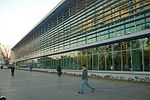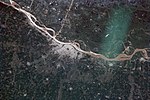Patio Parada
Rail infrastructure in ArgentinaRail transport in Rosario, Santa Fe

Patio Parada is a rail yard in Rosario, province of Santa Fe, Argentina. It is an important part of the railway system of the city and has been designed as the future site of a multi-modal public transport terminus. Formerly belonging to the Ferrocarril General Bartolomé Mitre company, it is now managed by the Nuevo Central Argentino (NCA) railway company. It employs a broad 5 ft 6 in (1676 mm) gauge railway.
Excerpt from the Wikipedia article Patio Parada (License: CC BY-SA 3.0, Authors, Images).Patio Parada
Avenida Bordabehere, Rosario Ludueña (Distrito Norte)
Geographical coordinates (GPS) Address Nearby Places Show on map
Geographical coordinates (GPS)
| Latitude | Longitude |
|---|---|
| N -32.932511111111 ° | E -60.678155555556 ° |
Address
Viaducto Ingeniero Emigdio Pinasco (Viaducto Avellaneda)
Avenida Bordabehere
S2002 Rosario, Ludueña (Distrito Norte)
Santa Fe, Argentina
Open on Google Maps










